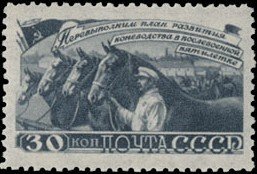Stamp: Let's overfulfil the plan in development of horse breeding! (Soviet Union, USSR 1948)
Let's overfulfil the plan in development of horse breeding! (Soviet Union, USSR 1948)
30 September (Soviet Union, USSR ) within release Agriculture goes into circulation Stamp Let's overfulfil the plan in development of horse breeding! face value 30 Russian kopek
| Stamp Let's overfulfil the plan in development of horse breeding! in catalogues | |
|---|---|
| Michel: | Mi:SU 1256 |
Stamp is horizontal format.
Also in the issue Agriculture:
- Stamp - Let's overfulfil the plan in development of horse breeding! face value 30;
- Stamp - Cattle (Bos primigenius taurus) face value 60;
Stamp Let's overfulfil the plan in development of horse breeding! it reflects the thematic directions:
An economy is an area of the production, distribution and trade, as well as consumption of goods and services. In general, it is defined as a social domain that emphasize the practices, discourses, and material expressions associated with the production, use, and management of resources. A given economy is a set of processes that involves its culture, values, education, technological evolution, history, social organization, political structure, legal systems, and natural resources as main factors. These factors give context, content, and set the conditions and parameters in which an economy functions. In other words, the economic domain is a social domain of interrelated human practices and transactions that does not stand alone.
The horse (Equus ferus caballus) is one of two extant subspecies of Equus ferus. It is an odd-toed ungulate mammal belonging to the taxonomic family Equidae. The horse has evolved over the past 45 to 55 million years from a small multi-toed creature, Eohippus, into the large, single-toed animal of today. Humans began to domesticate horses around 4000 BC, and their domestication is believed to have been widespread by 3000 BC. Horses in the subspecies caballus are domesticated, although some domesticated populations live in the wild as feral horses. These feral populations are not true wild horses, as this term is used to describe horses that have never been domesticated, such as the endangered Przewalski's horse, a separate subspecies, and the only remaining true wild horse. There is an extensive, specialized vocabulary used to describe equine-related concepts, covering everything from anatomy to life stages, size, colors, markings, breeds, locomotion, and behavior.
Agriculture is the cultivation and breeding of animals, plants and fungi for food, fiber, biofuel, medicinal plants and other products used to sustain and enhance human life.[1] Agriculture was the key development in the rise of sedentary human civilization, whereby farming of domesticated species created food surpluses that nurtured the development of civilization. The study of agriculture is known as agricultural science. The history of agriculture dates back thousands of years, and its development has been driven and defined by greatly different climates, cultures, and technologies. Industrial agriculture based on large-scale monoculture farming has become the dominant agricultural methodology.



